Reviews
SimCity
March 18, 2013, Author: James Sheppard
There has been a disappointing lack of quality, accessible simulation titles over the last few years. Like many long-time PC gamers I have fond memories of Theme Park, Theme Hospital, Rollercoaster Tycoon and, of course, SimCity. These were well-loved franchises that struck the rare and difficult balance of appealing to both hardcore and casual gamers.
What have we had recently? Cities XL has failed to reach the standards set by the city-building Granddaddy, and there’s been a slew of shovelware such as Farming Simulator, Street Cleaning Simulator and Delivery Truck Simulator. Tropico is one of the only notable series I can think of in years.
A decade since SimCity 4, however, Maxis have decided it’s about time they show everyone how it’s done and resurrect SimCity, with the release of… err… SimCity.
We built this city on always-online connections
If you follow gaming news, there’s a good chance you’re aware of the severe connection problems that plagued the game on release, and still haven’t fully been resolved. The internet has been a furious maelström of stories about frequent error messages, disillusioned fans, hours of lost saves and refused refunds. It’s like the Diablo III Error 37 debacle all over again, although probably even worse.
With always-online DRM fully integrated into SimCity, all players need to be connected to the internet whilst playing, all the time. Even for single-player. The problem is, EA apparently didn’t realise such a feat would require massive server resources. For one of the biggest PC releases this year. Of one of the biggest simulation franchises of all time.
Every day, there seems to be new fuel added to the fire. EA promised the later international release wouldn’t suffer like the American version. It did. They said they’d consider giving refunds and removing the DRM. They changed their minds. They claimed that the game couldn’t possibly work offline, because part of the processing is server-side. A hacker made it work flawlessly.
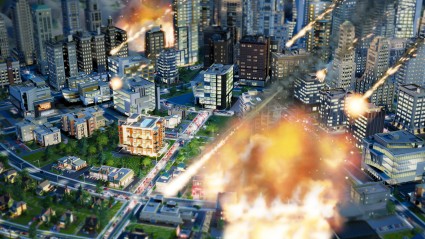
An internet rage of cataclysmic proportions
Whether the DRM and server issues are a problem is up to you and your personal circumstances. I personally waited for a few days after release until I tried the game, to avoid much of the hassle. There’s no doubting that its now infamous launch has created a lot of ill-will with fans, however.
Keys to the village
Now that SimCity’s mostly working, you start by creating your own region of cities or jumping into someone else’s. The latter option makes much more sense as you can enter into an already-established community, but the implementation is poor. It took me quarter of an hour to find a region with an empty slot for my first city, as it just kept showing me full regions. A ‘matchmaking’ option that would automatically place you in an empty city is a no-brainer that I can’t believe doesn’t exist.
Once you’re claimed your stake and started to construct those first roads and residential areas, a massive realisation hits you, or rather, a tiny realisation.These plots of land are miniscule. Gone are the days of creating sprawling metropolises; everyone has the same small square of ground to cram as much into as is physically possible. Which isn’t a lot.
This radical departure from previous SimCity titles is fundamental to the new social, always-online philosophy this new iteration clings so dearly to its heart. Instead of building an all-singing, all-dancing city, you’ll be specialising in certain areas and counting on players in your region to pick up the slack in others. Is your police force lacking? That’s okay; ask a nearby city to share patrol cars with you. Does your area naturally have low water resources? No problem; buy some off other players to compensate.
Whether you agree with the new direction of the series or not, there’s no denying that the small city sizes make sense. If you could have it all, there would be no need to co-operate with other cities in your region.
They really are cripplingly small, though. It may only take an hour to build your city up to its borders, after which the focus is on optimisation, optimisation, optimisation. As time goes on your citizens will build skyscrapers in an effort to continue expanding, and you’ll be faced with difficult decisions and a constant juggling act in order to make the most of what little space you have.
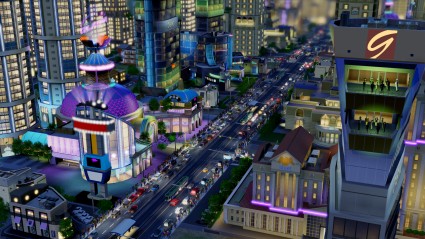
Hello, and welcome to Sardine-Tin City!
An unfortunate downside of this is less creative freedom, something which should be paramount in a building game. A great new addition to your toolset is curved roads, letting you create aesthetically pleasing streets. The problem is, these are a much less efficient way of fitting buildings in your city. As a result, everyone’s city inevitably looks the same; a generic, tightly-packed square. Terraforming is no longer an option, and general layout is the main way in which to personalise your city visually.
What’s worse about the roads system is how they’re upgraded. With limited initial funds, it makes sense to start with dirt roads and work your way up as the city develops. The road upgrade tool is a great solution, letting you click existing roads to expand their number of lanes. That is, until you reach the point of needing avenues.
Let me be clear about this: avenues aren’t necessary until your city is well-developed and developing skyscrapers, at which point congestion can become a real problem. However, there is no way to upgrade to avenues. You literally have to bulldoze and recreate every street.
This would be bad enough, if it wasn’t for the fact that all buildings are attached to roads. When you take down the road, the building goes with it. Your hours and hours of hard work are slowly torn away from you as you painstakingly have to demolish and rebuild your entire city. An added ‘bonus’ is that avenues are wider than regular roads, meaning you’ll have even less room when you’re finished than you had to begin with. Maxis, you cruel swines!
There are benefits to the new smaller city size, even if it has subjected the game to snide remarks of ‘SimTown!’ and ‘SimVillage!’. Rather than absent-mindedly plopping down buildings wherever you feel like, every action, every decision needs careful planning. In taking away building space, they’ve intensified the management of the game, and that has given the side effect of making SimCity truly absorbing.
Complementing this management focus is a new, streamlined approach and user interface. Constructing standard buildings is as simple as mapping out differently coloured RCI zones: green for residential, blue for commercial and yellow for industrial. Your Sims will do the rest. You’re in complete control of which services and amenities to build and where to put them, but this hands-off approach towards general construction lets you concentrate on more important matters.
Don’t be under the illusion that the depth of simulation has been overly simplified this time round. A mass of factors need to be considered and influenced by your input. Rather than having to wade through pages of statistics and bar charts, however, many of them can be visualised with the superb new land maps. There are a huge range of these including pollution levels, crime hotspots and population density. Click the one you need, and the city greys out like an unpainted Airfix model, with coloured overlays showing you everything you need to know.
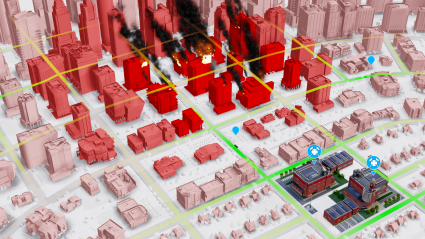
And this land map tells me that…. bad shit is going down.
The land value map is a particularly interesting one that you’ll be referring to often. Create factories, airports and garbage dumps and the ground nearby will seep blood-red stains, showing undesirable areas. Build parks and attractions, however, and it’ll become a deep shade of teal, representing higher land value. This has a massive bearing on residential and commercial areas, as it determines whether low-wealth or high-wealth properties will be constructed; and as any budding mayor should know, higher-wealth citizens means higher taxes!
Other features that show the status of your city include an easy-to-follow chart of your profits and outgoings; simple coloured bars that indicate demand for certain RCI sectors; meters that visualise power generation, sewage control and water supply; and quick breakdowns of the stats for your services like police, firefighters and education. There’s a lot of simulation to keep on top of in SimCity, but it does a stellar job of making the information accessible and easy to understand.
It’s unfortunate then, that many of the simulation aspects are broken, or at least don’t work as well as they should do. For instance, the Sims that walk and drive down the streets of your city have very rudimentary A.I. This is a problem, because they’re not just there for show; a cop car, for example, genuinely represents a member of your police force chasing down criminals.
Whilst this is a brilliantly immersive touch, the pathfinding is dire. Sims literally calculate the shortest route from A to B and drive down these routes, creating massive traffic jams in city centres whilst parallel roads nearby are left completely empty.
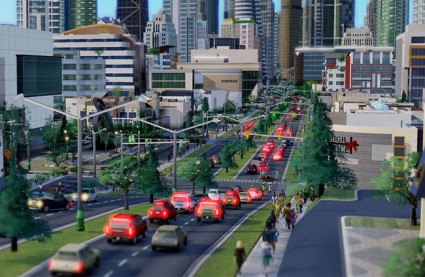
I calculate this route is the shortest by approximately 13.6 metres. This way, everyone!
They’re also happy to speak their mind about the city, but their poor little chicken-brains don’t seem to have any concept of what’s truly going on. If your police force and healthcare records are exemplary, you’ll still get Sims complaining: ‘Too much crime!’, and ‘So many people are dying. It’s horrible!’. On the other hand, it’s actually possible to create a fully residential city with absolutely no commercial or industrial buildings, and still have happy residents as long as you build lots of parks. Dimwitted cretins.
In the grand scheme of things, however, these issues rarely let your enjoyment of the game falter. Maxis have also promised they’re working on many of the simulation bugs, particularly the traffic pathfinding.
It is important to bear in mind how SimCity is structured, as some will enjoy this more than others. Even the main non-Sandbox mode is still very much a sandbox, giving you free reins to do whatever you wish with your city. There are only occasional objectives that you are free to disregard, and no scenarios to play through.
Whereas many will love the freedom this offers you, it can at times feel a little directionless. I actually found myself wishing for the story objectives and side-missions of Tropico. The goals to be found in SimCity are those that you set yourself, however. Maybe you wish to craft a flourishing tourist hotspot, a seedy gambling paradise or become a wealthy oil baron. Perhaps you just want to build your city up then wreak havoc on the population with giant killer dinosaurs. The choice is yours.
Seeing the sights
Much like its smaller-scale life simulator The Sims, SimCity takes a half-realistic, half-cartoon approach to its visuals. With the camera panned out it looks fairly life-like, but zoom in and you’ll see charming little caricatures of people, solid blocks of colour as opposed to hyper-realistic textures, and a beautiful tilt-shift camera effect that really makes it feel like your very own model city.
It’s obvious that Maxis are aiming for all audiences here. They’ve not pushed the boat out graphically, helping to keep the system requirements low. Nonetheless, the lighting effects are pleasing to look at as the sun comes up, or as night descends and your cityscape becomes a mass of golden skyscraper window lights.
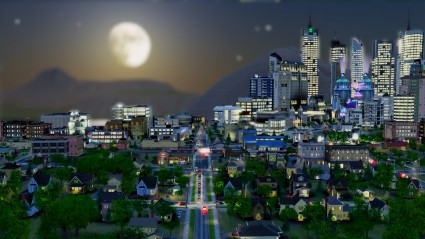
Who said urbanisation has to be ugly?
There’s no over-the-top bloom or HDR lighting reflecting off everything; it’s understated and graceful. Rather than throw the latest visual effects your way, SimCity impresses with all of its intricate details and animations. It’s all too tempting to take a break every now and then, and just pan the camera around your city to see what your little Sim sea-monkeys are up to.
Noise pollution
Bouncy, uplifting melodies accompany your important mayorly duties in SimCity, the likes of which you’ll once again be accustomed to from previous Sims games. Nothing particularly grabs you by the throat, but after you’ve inevitably spent hours with the game you’ll find that the soundtrack has weaseled its way into your brain.
Perhaps the most cunning aspect of the sound design is the various little effects that accompany your actions. A cash register ‘cha-chings’ every time you earn money and the clunky noises that ring out when you plot RCI zones bear more than a little resemblance to a casino slot machine. As if your brain needed any more persuasion to stay hooked…
Slums or skyscrapers?
Now that much of much of the server problems are behind us, city builders can delve into SimCity and lose themselves in their creations. Memories of the drama that unfolded will serve as stark warnings to developers and gamers alike in the future, but that’s all they’ll soon be: memories.
That’s not to say that the game is perfect yet. There are technical issues and some elements of design that are questionable or badly implemented. The new, smaller city size may be a deal breaker for some, although it’s obvious why the choice was made. Likewise, always-online DRM will be a serious issue for those with flaky internet connections, although you’re at least given 20 minutes’ grace whilst your tubes try and reconnect.
What can’t be taken away from it, however, is that this new breed of SimCity is a hell of a lot of fun. Most importantly, it’s compulsively, absorbingly, unrelentingly addictive.
Let me put it into perspective for you. I recently booted up the game in order to quickly find out something for the purposes of this review. An hour and a half later, as I was expanding my city’s mass transit capacity and deciding where to place my next tourist attraction, it dawned on me that I had never intended to actually play the game. I’d forgotten to even find out the information I needed. Whoops.
Platforms: PC | Tagged 2000, 3000, addictive, always-online, city builder, drm, EA, Maxis, simcity, Simulation, The Sims



